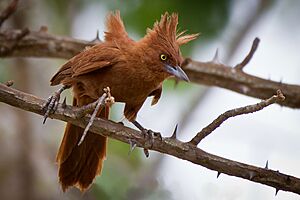Caatinga cacholote facts for kids
Quick facts for kids Caatinga cacholote |
|
|---|---|
 |
|
| In Paraíba, Brazil | |
| Conservation status | |
| Scientific classification | |
| Genus: |
Pseudoseisura
|
| Species: |
cristata
|
 |
|
The Caatinga cacholote (Pseudoseisura cristata) is a cool bird that lives only in Brazil. It's part of the ovenbird family called Furnariidae. These birds are known for building interesting nests. This species is special because it's found only in a specific dry forest area in Brazil called the Caatinga.
Contents
About This Bird's Name
The Caatinga cacholote is a unique type of bird. Long ago, another bird, the grey-crested cacholote (P. unirufa), was thought to be the same species. But scientists studied them closely and found they were different. So, now they are known as separate species.
What Does the Caatinga Cacholote Look Like?
This bird is about 25 to 26 centimeters (10 inches) long. It's a fairly large bird with a long beak and a crest on its head. Both male and female Caatinga cacholotes look the same.
Colors and Features
Adult birds are mostly a bright reddish-brown color. Their belly and chest are a bit lighter. The tips of their flight feathers (the long feathers used for flying) are dark. The ends of their tail feathers don't have the usual feathery parts. Their eyes are yellow.
Young Birds
Young Caatinga cacholotes have a shorter crest than adults. They might have some dark streaks or bars on their face and underparts. Their eyes are a bluish-gray color.
Where Does the Caatinga Cacholote Live?
The Caatinga cacholote lives in eastern Brazil. You can find it in areas like eastern Maranhão, Paraíba, and central Minas Gerais.
Favorite Places to Live
It likes to live in the woodlands and scrub areas of the Caatinga biome. It also lives in tropical forests where trees lose their leaves in the dry season. This bird is often seen near homes in areas that aren't too crowded with people. It lives at elevations from about 50 to 500 meters (160 to 1,600 feet) above sea level.
How Does the Caatinga Cacholote Behave?
Movement and Home
The Caatinga cacholote stays in the same area all year round. It does not migrate to other places.
What Does It Eat?
This bird eats arthropods, which are creatures like insects and spiders. It also eats some plant material. Caatinga cacholotes usually look for food in pairs. They often search on the ground, where they poke and dig to find their prey.
How Does It Raise Its Young?
Scientists don't know exactly when the Caatinga cacholote's breeding season is. Most of the time, these birds are believed to stay with one partner. However, some observations have shown up to four adult birds helping to feed the baby birds in a nest. It's not known if these helpers are related to the main pair.
Building a Nest
Their nest is a big pile of thorny sticks. It's usually twice as long as it is wide. They often build it in a tree fork or on a utility pole. The nest has an entrance tunnel near the top that leads to a hidden inner room. This inner room is lined with pieces of tree bark and even snake skin! One nest found in Ceará had many unusual items. These included razor blades, a fork, plastic pieces, paper, and barbed wire. Scientists still need to learn more about how many eggs they lay, how long the eggs take to hatch, and how long the babies stay in the nest.
What Does It Sound Like?
Caatinga cacholotes often sing together in a duet. One bird, probably the male, makes a long series of very loud, clear "tjew" notes. The other bird, probably the female, replies with 15 to 35 buzzy "zjeep" notes. The bird's call is a single "chuk" sound.
Is the Caatinga Cacholote in Danger?
The IUCN (International Union for Conservation of Nature) has said the Caatinga cacholote is of "Least Concern." This means it's not currently in danger of disappearing.
Why It's Not Threatened
This bird lives in a large area, and its population size is believed to be growing. No immediate threats have been found. It's considered common, especially in areas where the caatinga forest has been changed or overgrazed. It has even spread to new areas where forests have been cleared. Plus, it lives in several protected areas, which helps keep it safe.


